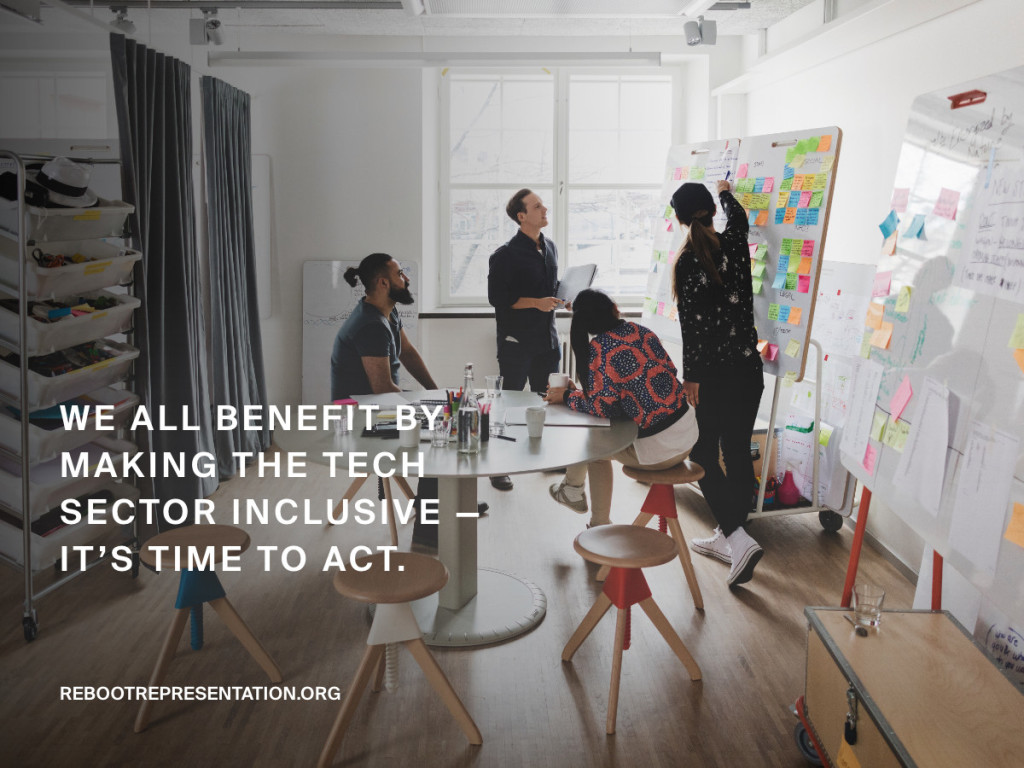Chances are good that, right now, someone in Silicon Valley is working on something that will change your life. Technologists are designing an app that will connect you to a service, an innovation that will disrupt your industry, a new technology that will transform your world.
Twenty-first century life is full of reminders that technology companies wield outsized influence over our futures. And because the decisions they make affect all of us, it’s crucial that the people making these decisions represent all of us, too. As technology’s role in society grows, so does the urgency of diversifying the tech sector.
As technology’s role in society grows, so does the urgency of diversifying the tech sector.
It’s no secret that women are still severely underrepresented in tech at every stage of the pipeline. Women earn only 19 percent of computing degrees, and most of those degrees are going to white women. Although black, Latina, and Native American women make up roughly 16 percent of the population, they’re graduating with only 4 percent of computing degrees. What’s worse, the trends are actually going in the wrong direction.

Unsurprisingly, the gender gap in computing degrees translates to a gender gap in the tech workforce. According to the National Center for Women & Information Technology, in 2017, women held only 26 percent of jobs in the computing workforce. The data on women of color is less robust—in part because companies don’t always report it—but they are, without question, the most underrepresented group in tech. In 2017, black women held only 3 percent of computing jobs, and Latinas just 1 percent.
These facts carry troubling implications not only for the individual ambitions of aspiring technologists but for the collective potential of the sector. A growing body of evidence suggests that diverse teams are more creative, more productive, and more profitable than teams whose members all look and think alike.

Many tech companies acknowledge that they have a lot to gain by making diversity a priority. As a philanthropist, I’m even more interested in what they can contribute.
Already, tech companies spend billions of dollars every year on philanthropy and corporate social responsibility. I wanted to understand how much of that spending is going toward gender diversity—and whether the tech companies who say they want to be part of the solution can do more to put their money where their mouth is.
To answer these questions, my company, Pivotal Ventures, partnered with McKinsey & Company to learn more about how tech companies approach their philanthropic and social responsibility initiatives. Over the course of our research, we engaged with 32 leading technology companies and 100 of the industry’s top executives and experts. Ours isn’t the first report to explore tech’s diversity problem, but it is the first to enlist tech companies themselves to design a solution.
Our findings, released today in a report entitled “Rebooting Representation: Using CSR and Philanthropy to Close the Gender Gap in Tech,” reveal that gender diversity is not yet a philanthropic priority for the technology sector. The 32 technology companies included in this survey spent a total of $500 million on philanthropic giving in 2017, but only 5 percent of that $500 million went toward gender diversity efforts.
We also found that, although the companies expressed a strong desire to increase the number of black, Latina, and Native American women and girls in their ranks, less than .1 percent of their 2017 philanthropic giving focused on women of color specifically. In other words, there is clear opportunity for diversity-minded companies to use their existing spending more effectively.
Already, these companies are putting our findings into action. Today, twelve companies will announce the launch of the Reboot Representation Tech Coalition, a joint effort to close the gender gap for women of color in tech that aims to double the number of black, Latina, and Native American women graduating with computing degrees by 2025.
The Reboot Representation Tech Coalition is pledging more than $12 million to this goal—which is more than 30 times what the 32 companies we surveyed spent last year on programs for women and girls of color. The coalition’s priorities include reexamining the computing degree experience to attract more women of color and building communities to support these women throughout their tech journeys.
The #RebootRepresentation Tech Coalition is pledging more than $12 million to this goal—which is more than 30 times what the 32 companies we surveyed spent last year on programs for women and girls of color.
Even more notable than the dollar amount the coalition has pledged is the fact that its members have committed to spending these funds collectively. The gender gap in tech was not created by any one company and cannot be solved by any one company either. This collective action model enables companies to work together toward their shared goal with a unified strategy, shared metrics, and clear accountability. By leveraging each other’s core capabilities, each member will be positioned to maximize their impact. And, most importantly, by working together, they will be able to reach more young women.
I love imagining these young women and the futures ahead of them. They may or may not be thinking about careers in tech yet. But it matters that tech is thinking about them.
Source: LinkedIn
Author: Melinda Gates
